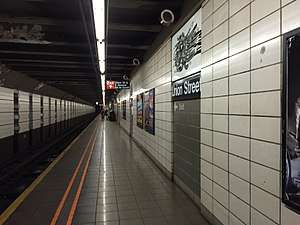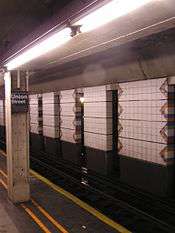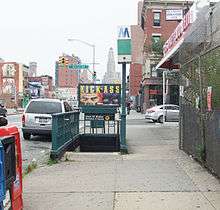Union Street (BMT Fourth Avenue Line)
Union Street | |||||||||||||
|---|---|---|---|---|---|---|---|---|---|---|---|---|---|
|
| |||||||||||||
 Manhattan bound platform | |||||||||||||
| Station statistics | |||||||||||||
| Address |
Union Street & Fourth Avenue Brooklyn, NY 11217 | ||||||||||||
| Borough | Brooklyn | ||||||||||||
| Locale | Park Slope | ||||||||||||
| Coordinates | 40°40′41″N 73°59′02″W / 40.678108°N 73.98391°WCoordinates: 40°40′41″N 73°59′02″W / 40.678108°N 73.98391°W | ||||||||||||
| Division | B (BMT) | ||||||||||||
| Line | BMT Fourth Avenue Line | ||||||||||||
| Services |
D N R W | ||||||||||||
| Transit connections |
| ||||||||||||
| Structure | Underground | ||||||||||||
| Platforms | 2 side platforms | ||||||||||||
| Tracks | 4 | ||||||||||||
| Other information | |||||||||||||
| Opened | June 22, 1915[1] | ||||||||||||
| Station code | 028[2] | ||||||||||||
| Traffic | |||||||||||||
| Passengers (2017) |
1,935,724[3] | ||||||||||||
| Rank | 254 out of 425 | ||||||||||||
| Station succession | |||||||||||||
| Next north |
Atlantic Avenue – Barclays Center: D | ||||||||||||
| Next south |
Ninth Street: D | ||||||||||||
| |||||||||||||
| |||||||||||||
| |||||||||||||
Union Street is a local station on the BMT Fourth Avenue Line of the New York City Subway. It is located at the corner of Fourth Avenue and Union Street in Brooklyn, New York City, serving the communities of Park Slope, Gowanus and Carroll Gardens. It is served by the R train at all times. The D and N trains also stop here during late nights, and a few rush-hour W trains stop here in the peak direction.
History

Union Street opened on June 22, 1915 as part of the initial portion of the BMT Fourth Avenue Line to 59th Street.[4]
The station was renovated twice. The first time was in the late 1970s. The repairs includied repairing the staircases and platform edges, replacing the incandescent lighting with fluorescent lighting, and replacing the original platform wall tiles and mosaic signs with cinderblock tiles. The wall tiles are colored white except for small recesses where the platform signs (in the standard white lettering and black background) are, where they are colored gray.
The station was renovated again from 1990 to 1994. In addition to upgrading the same elements that were replaced in the previous overhaul, tiling on floors and track walls, the public announcement system, and safety treads along platform edges and track-beds were replaced. It also included an art installation by Emmett Wigglesworth called CommUnion.[5] It features twenty-two panels of various designs in the recessed area of the platform tiles above the station signs and other designs on the openings in the track walls.
Station layout
| G | Street level | Exit/entrance |
| M | Mezzanine | Fare control, station agent, MetroCard machines |
| P Platform level |
Side platform, doors will open on the right | |
| Northbound local | ← ← ← | |
| Northbound express | ← | |
| Southbound express | → | |
| Southbound local | | |
| Side platform, doors will open on the right | ||

This underground station has four tracks and two side platforms. The center express tracks are used by the D and N during daytime hours. A black and white curtain wall separates them from the local tracks.
Both platforms are columnless except for a section at their extreme north ends, where they were extended in the 1950s to accommodate the standard length of a B Division train (600 feet). Here, the columns are cream colored I-beams.
Exits
Each platform has one same-level fare control area in the center and there are no crossovers or crossunders to allow free transfer between directions. The Manhattan-bound side has a fare control area, a turnstile bank, token booth, and two street stairs. The one on the Manhattan-bound platform goes up to the southeast corner of Union Street and Fourth Avenue while the one on the Bay Ridge-bound platform goes up to the southwest corner. The Bay Ridge-bound side has a fare control area, a turnstile bank without a token booth, and two street stairs.[6]
References
- ↑ "Through Tube to Coney, 48 Minutes: First Train on Fourth Avenue Route Beats West End Line Eleven Minutes". Brooklyn Daily Eagle. June 22, 1915. Retrieved 29 June 2015 – via Newspapers.com.
- ↑ "Station Developers' Information". Metropolitan Transportation Authority. Retrieved June 13, 2017.
- ↑ "Facts and Figures: Annual Subway Ridership 2012–2017". Metropolitan Transportation Authority. July 12, 2018. Retrieved July 12, 2018.
- ↑ "Through Tube to Coney, 48 Minutes: First Train on Fourth Avenue Route Beats West End Line Eleven Minutes". Brooklyn Daily Eagle. June 22, 1915. Retrieved June 29, 2015 – via Newspapers.com.
- ↑ "Arts for Transit: CommUnion". MTA Arts for Transit. Retrieved 2007-06-02.
- ↑ "MTA Neighborhood Maps: Park Slope" (PDF). mta.info. Metropolitan Transportation Authority. 2015. Retrieved 2 August 2015.
External links
| Wikimedia Commons has media related to Union Street (BMT Fourth Avenue Line). |
- nycsubway.org – BMT 4th Avenue: Union Street
- The Subway Nut — Union Street Pictures
- MTA's Arts For Transit — Union Street (BMT Fourth Avenue Line)
- Union Street entrance from Google Maps Street View
- Platform from Google Maps Street View



